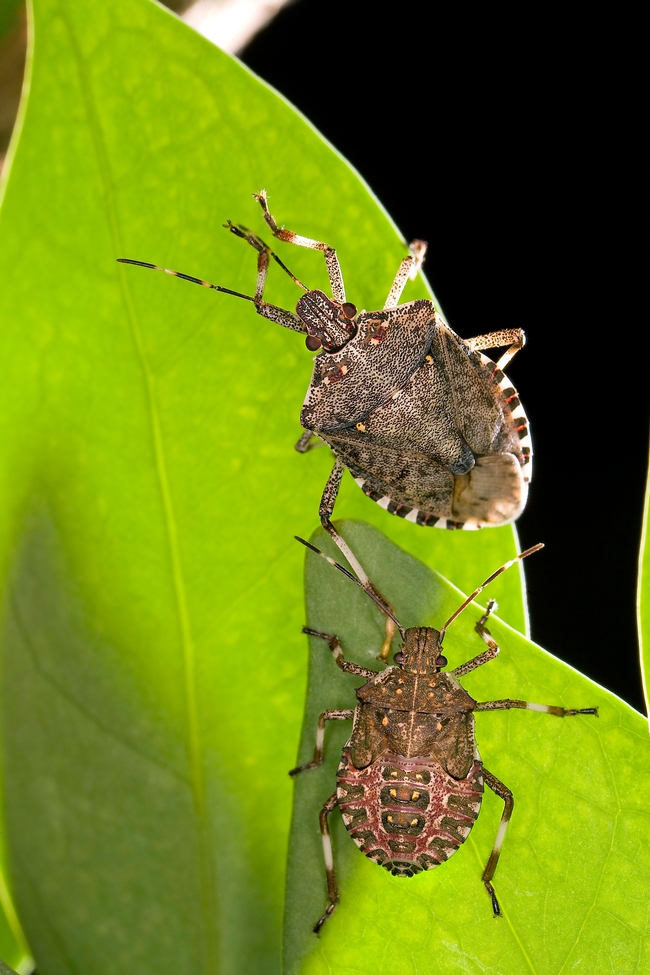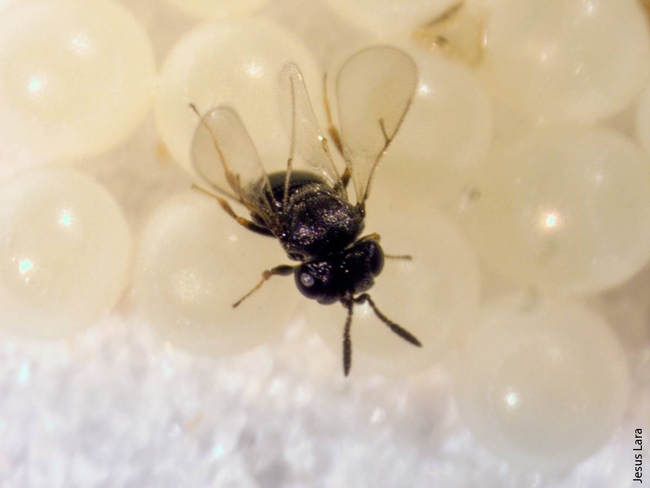Posts Tagged: biological control
UC and CDFA researchers make progress in fight against exotic brown marmorated stink bugs
Scientists are rearing tiny Asian wasps in quarantine and evaluating whether they can be released in California to battle brown marmorated stink bug (BMSB), an invasive pest that poses a serious threat to the state's $54 billion agricultural industry, they reported in the current issue of California Agriculture journal.
The wasp, Trissolcus japonicus, has scientists feeling hopeful, said Chuck Ingels, UC Cooperative Extension advisor in Sacramento County and one of the 10 authors of the article. Ingels and a team of UC and California Department of Food and Agriculture scientists have been closely monitoring BMSB since large populations were found in downtown Sacramento in 2013.
“We hope T. japonicus will render BMSB a much lower threat, to where it might end up a background stinkbug,” Ingels said. “It all depends on how well the parasitoid adapts to our climate if we get to the point of releasing it.”
At the moment, BMSB has not caused significant damage to agricultural crops in California, but UC scientists want to be ready with solutions should it migrate into farms. BMSB – a native of China, Korea, Japan and Taiwan – made its way to the East Coast of the U.S. in the 1990s. By 2010, it caused millions of dollars in crop damages in apples, peaches and vegetables. The pest was first detected in California in 2002. It is now in urban communities in Siskiyou, Butte, Sutter, Yolo, Sacramento, San Joaquin, Stanislaus, Santa Clara and Los Angeles counties.
In urban areas, the pest is a nuisance. Bugs aggregate in late summer on walls and trees, and then seek refuge in the winter inside homes, garages and other buildings. Massive aggregations of BMSB are a disturbing sight and emit a pungent cilantro-like odor. In restaurants, BMSB can alarm patrons when the insects are mistaken for cockroaches, potentially hurting the eatery's bottom line.
“Apartment managers complain that tenants are threatening to move out because of the stink bugs,” Ingels said. “It's an economic issue.”
But BMSB's potential for damage in commercial agricultural crops portends a much greater economic threat. BMSB's host plant range of 170 species includes many valuable fruit, nut, vegetable and ornamental crops. In August and September of 2015, BMSB was found feeding on citrus, persimmons and apples in a Sacramento community garden. In July 2015, BMSB was found for the first time in traps placed close to citrus, kiwi and avocados in Los Angeles County backyards.
Already, several “generalist predators” have been observed feeding on BMSB – such as lacewings, mantids, earwigs, lady beetles, assassin bugs, pirate bugs, big-eyed bugs and spiders. Field research has also found that at least 12 North American species of stink bug egg parasites will lay eggs in BMSB egg masses.
However, because the local species may not be enough to provide adequate levels of population suppression, the researchers are interested in T. japonicus, a natural enemy of BMSB in its home range in China. The wasp can help to control populations of BMSB by laying its own eggs inside BMSB eggs. The researchers say finding and establishing a host-specific natural enemy may significantly increase control and prevent further economic problems.
“The introduction of a beneficial natural enemy like T. japonicus, which co-evolved with BMSB in China, increases our chances of successfully targeting and suppressing BMSB populations in the United States,” said Ricky Lara, a post-doctoral scholar at UC Riverside and lead author of the article. “In California, UC and CDFA researchers will continue to conduct the required safety evaluations with T. japonicus to deliver a cost-effective BMSB biological control program.”
Without being introduced by authorities, T. japonicus have been found in Maryland, Virginia and Vancouver, Wash., presumably having been accidentally introduced via parasitized BMSB eggs from Asia. DNA analyses determined that the T. japonicus collected in the field did not originate from the populations in quarantine, indicating that there have been no accidental escapes from these secure facilities.
The California research was funded with a grant from the CDFA Specialty Crop Block Grant Program, which was awarded to Charles Pickett, CDFA senior environmental scientist specializing in biological control, and Mark Hoddle, UC Cooperative Extension biological control specialist. Funding was also provided by the USDA Farm Bill, the California Pistachio Research Board, the Pear Pest Management Research Fund and the Consolidated Central Valley Table Grape Pest and Disease Control District.
Invasive meltdown
Ants can be a huge nuisance in and outside our homes, particularly if you have food lying around. But now, it turns out, they’re unwelcome, too, on citrus trees.
A year ago, UC Riverside entomologists released Tamarixia, a parasitoid wasp and natural enemy of the Asian citrus psyllid (ACP) imported from Pakistan, into a biocontrol grove in Riverside, Calif. Tamarixia can serve as an excellent biocontrol agent against ACP, a citrus pest first detected in 2008 in Southern California that is capable of spreading citrus greening disease, or Huanglongbing.
Tamarixia’s success starts with a female laying an egg on the underbelly of an ACP nymph. When the egg hatches, the parasitoid larva will scrape away the nymph’s belly, carving out a hole to push through to enter the nymph’s body. Feeding on the contents, the larva eventually excavates the entire nymph, leaving only a shell or husk of the nymph behind.
Female Tamarixia can kill psyllids also by “host-feeding.” They use their ovipositors as daggers to stab psyllid nymphs numerous times until the nymphs start to bleed. As bodily fluids ooze out of the nymph, Tamarixia sucks up this rich protein needed for developing more eggs.
An excellent way then to control ACP populations! Yes, but only until the ants come marching in. Argentine ants are threatening to disrupt the biocontrol of ACP by battling it out with Tamarixia on citrus branches. While not quite a Vader-Skywalker lightsaber duel on a precarious walkway, an “invasive meltdown” begins when the ants gang up to protect the nymphs.
“ACP nymphs produce a white, sugary waste product called honeydew, a good carbohydrate source for the ants,” explains Mark Hoddle, the director of the Center for Invasive Species Research at UC Riverside, whose research team has released Tamarixia into several Southern California citrus groves. “The ants, therefore, will protect the nymphs from Tamarixia. We have seen ants chase female Tamarixia off the psyllids, and even catch and eat them!”
“If you kill off the ants, Tamarixia can play the role of the biocontrol agent it was cast to do on citrus trees,” Hoddle says. “We’re seeing that the ants are impacting Tamarixia in two ways: they are preventing Tamarixia’s establishment in some areas; and, where Tamarixia is already established, the ants are not allowing these parasitoids to reach their full biocontrol potential.”




